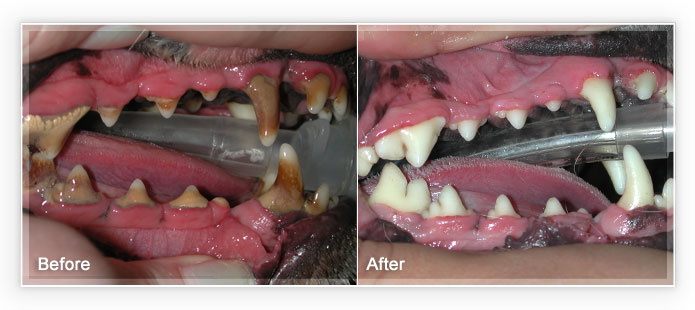 Pet Dental Care
Pet Dental Care
It is estimated that up to 90% of all dogs and cats over the age of three suffer from some degree of tooth decay and gum disease. Early and proper prophylactic teeth cleanings can help prevent problems such as tartar accumulation under the gum line and gingivitis, which cause ligaments to break down that connect the teeth with bone and gum tissue.
One week prior to a dental cleaning, we recommend an antibiotic regimen to help prevent treatment-induced bacteremia and to control infections. Stomatitis (inflammation of the mucous lining of the mouth) and multiple-extractions also benefit from receiving antibiotics prior to cleaning.
During a professional dental cleaning, your pet receives an oral checkup while under anesthesia and extractions are made as needed. Ultrasonic scaling above and below the gumline removes the debris that often goes unnoticed yet is the primary element of periodontal disease. The next phase is polishing the teeth, which makes your pet's teeth more resistant to plaque buildup. Once your pet's teeth are cleaned and polished, the periodontal pockets are irrigated to remove plaque that surrounds the teeth.
A complete dental prophylaxis involves many steps from examination, charting, scaling and polishing to home care instructions. Each step is critical to the success of the procedure and vital to the overall success and improved health care of your pet. The success of the procedure is not determined when your pet recovers and leaves the hospital. Ensuring compliance of home care instructions and follow up examinations are also critical to the overall success of this treatment.
Home Dental Care
Dental care is not something that can be left to periodic visits with us. Because plaque buildup—the primary cause of poor oral health—is a gradual process occurring throughout the life of your pet, it is important to practice good home dental care. As with humans, this means regular tooth brushing and in some cases additional steps may be necessary. Any member of the our staff can show you the proper method for caring for your pet's teeth as well as help you select the most effective dental products for your pet.
You should also be able to recognize the signs of poor oral health. If you notice any of the following you may want to contact us:
- Persistent bad breath—one of the first signs of dental disease
- Tartar or plaque buildup (ask your veterinarian how to identify these)
- A yellowish-brown crust of plaque on the teeth near the gum line
- Red and swollen gums
- Pain or bleeding when your pet eats or when the mouth or gums are touched
- Pawing at the mouth
- Decreased appetite or difficulty eating
- Loose or missing teeth